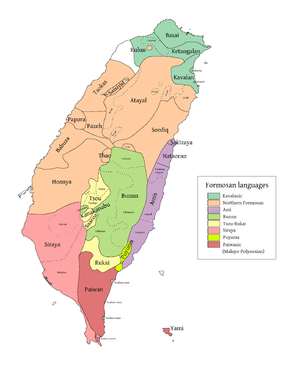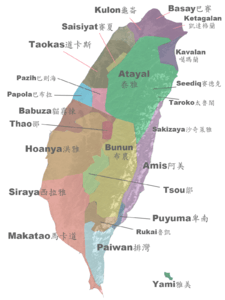Amis language
| Amis | |
|---|---|
| Pangcah [pant͡saʜ] | |
| Native to | Taiwan |
| Ethnicity | Ami |
Native speakers | 180,000 (2009)[1] |
| Language codes | |
| ISO 639-3 |
ami |
| Glottolog |
amis1246[2] |
|
(purple) Greater Ami | |
Amis is the Formosan language of the Amis (or Ami), an indigenous tribal people living along the east coast of Taiwan (see Taiwanese aborigines). It is spoken from Hualien in the north to Taitung in the south, with another population near the southern end of the island, though the northern varieties are sometimes considered a separate language.
Government services in counties where many Amis people live in Taiwan, such as the Hualien and Taitung train stations, broadcast in Amis alongside Mandarin. However, few Amis under the age of 20 in 1995 spoke the language, and it is not known how many of the 138,000 ethnic Amis are speakers.
Dialects
Amis is a dialect cluster. The northern varieties, Sakizaya and Nataoran, are divergent enough to be classified as a separate language or languages. Within Amis proper, there are Tavalong-Vata'an, Middle, and Southern dialects, the latter including Malan and Hengchun Amis.
Phonology
The following discussion covers the central dialect of Amis (Maddieson & Wright).
Consonants
| Labial | Dental | Alveolar | Palatal | Velar | Epiglottal | Glottal | |
|---|---|---|---|---|---|---|---|
| Nasals | m | n̪ | ŋ | ||||
| Plosives and affricate |
p | t̪ | t͡s | k | ʡ ~ я | ʔ | |
| Fricatives | v | ð̪ ~ ɮ̪ | s | (ɣ) | ʜ | h | |
| Trill | r | ||||||
| Lateral flap | ɺ̠ | ||||||
| Approximants | w | j |
The voiceless plosives /p t k ʡ/ and the affricate /t͡s/ are released in clusters, so that cecay "one" is pronounced [t͡sᵊt͡saj]; as is /s/: sepat "four" is [sᵊpat⁼]. The glottal stop is an exception, frequently having no audible release in final position. The voiced fricatives, /v ɮ ɣ/ (the latter found only in loanwords) are devoiced to [f ɬ x] in utterance-final and sometimes initial position. /ɮ/ may be interdental or post-dental. The sibilants, /t͡s s/, are optionally palatalized ([t͡ɕ ɕ]) before /i/. /j/ does not occur in word-initial position. /ɺ/ is often post-alveolar, and in final position it is released: [ʡuʡuɺ̠ᵊ] "fog".
/ɮ/ shows dramatic dialectical variation. In Fengbin, a town in the center of Amis territory, it is pronounced as a central dental fricative, [ð̪], whereas in the town of Kangko, only 15 km away, it is a lateral [ɮ̪]. In northern Amis, it is a plosive [d̪], which may be laxed to [ð̪] intervocalically. The epiglottals are also reported to have different pronunciations in the north, but the descriptions are contradictory. In Central Amis, /ʜ/ is always voiceless, and /ʡ/ is often accompanied by vibrations that suggest it involves an epiglottal trill, sometimes transcribed "я". Edmondson and Elsing report that these are true epiglottals initially and medially, but in utterance-final position they are epiglotto–pharyngeal.
Sakizaya, sometimes considered a northern dialect of Amis, contrasts a voiced /z/ with voiceless /s/.
In the practical orthography, /ts/ is written ⟨c⟩, /j/ ⟨y⟩, /ʡ/ ⟨'⟩, /ʔ/ ⟨^⟩, /ɮ/ ⟨d⟩, /ŋ/ ⟨ng⟩, and /ʜ/ ⟨x⟩.
Vowels
| Front | Central | Back | |
|---|---|---|---|
| Closed | i | u | |
| Mid | (ə̆) | ||
| Open | a |
Amis has three common vowels, /i a u/. Despite the fact that a great deal of latitude is afforded by only needing to distinguish three vowels, Amis vowels stay close to their cardinal values, though there is more movement of /a/ and /u/ toward each other (tending to the [o] range) than there is in front-vowel space (in the [e] range).
A voiceless epenthetic schwa optionally breaks up consonant clusters, as noted above. However, there are a small number of words where a short schwa (written e) may be phonemic. However, no contrast involving the schwa is known, and if it is also epenthetic, then Amis has words with no vowels at all. Examples of this e are malmes "sad", pronounced [maɺə̆mːə̆s], and ’nem "six", pronounced [ʡnə̆m] or [ʡə̆nə̆m].
Examples of words
|
|
|
- Compare with Tagalog baboy (pig), tatlo (3), apat (4), lima (5), anim (6), pito (7), walo (8)
- Compare with Kapampangan asu (dog), pusa (cat), atlo (3), apat (4), lima (5), anam (6), pitu/pito (7), walu/walo (8), siyam (9), apulu/apulo (10) and ama (father) and ima (mother)
- Compare with Ilokano baboy(pig), aso(dog), pusa(cat), maysa(1), dua(2), tallo(3), uppat(4), lima(5), inem(6), pito(7), walo(8), siam(9), sangapulo(10)
- maolah kako mimali = I like to play sports.
- takaraw ko pita’kod = I jump very high.
- kalamkam ko kacomikay = I run very fast.
- Ira ko tata’angay a mata ako = I have big eyes
- mamangay a ngoyos’= A small mouth
- takaya’ay a fokes = long hair
- sowal san ko kahacecay a tamdaw makapahay kako = Everyone tells me that I am beautiful.
- mafana’ay miasik, misawsaw to kaysing, milidong to fodoy = I can sweep the floor, wash dishes and clothing.
- maolah midemak kako to tayal no loma’ = I love to do household chores.
- nawhani maolah kako to loma’ no mako = Because I love my home.
Grammar
Verbs in the Amis language have some inflections, including existential clause, active voice, passive voice, disposal sentence, imperative mood, optative mood, and prohibitive mood.
There are two word orders in Amis language, called "General" Word Order and "Special" Word Order.
Below are some examples of Amis sentence:
"General" Word Order Sentence I : Verb–subject
| Verb | Subject |
|---|---|
| Verb, Adjective, etc. | ko (Preposition for Subjects)+Nouns |
Example
- Maomahay ko wama. (The father is working at the farmfield.)
- mimaomahay: Working (at farmfield)
- wama: Father
- Misaholoay ko wina. (The mother is cooking rice.)
- misaholoay: Cooking (rice)
- ina/wina: Mother
"General" Word Order Sentence II : Verb–subject–object
| Verb | Subject | Object |
|---|---|---|
| Verb, Adjective, etc. | ko (Preposition for Subjects)+Nouns | to (Preposition for Objects)+Nouns |
Example
- Mifaca' ko kaying to riko'. (The young woman is washing clothes.)
- Mifaca' koya kaying to riko'. (That young woman is washing clothes.)
- mifaca': wash(clothes)
- kaying: young woman
- riko'/fudoy: clothes
Notes
- ↑ Council of Indigenous Peoples of Executive Yuan, Taiwan
- ↑ Nordhoff, Sebastian; Hammarström, Harald; Forkel, Robert; Haspelmath, Martin, eds. (2013). "Amis". Glottolog. Leipzig: Max Planck Institute for Evolutionary Anthropology.
- ↑ http://language.psy.auckland.ac.nz/austronesian/language.php?id=800
- ↑ http://language.psy.auckland.ac.nz/austronesian/language.php?id=799
- ↑ http://language.psy.auckland.ac.nz/austronesian/language.php?id=801
References
- Edmondson, Jerold; John Esling. "The valves of the throat and their functioning in tone, vocal register, and stress: laryngoscopic case studies" (PDF). Retrieved 2008-11-13.
- Gils, Rémy, 2010. Parlons amis: Une langue aborigène de Taïwan, Paris, L'Harmattan. ISBN 2-296-11465-2
- Maddieson, Ian; Richard Wright (October 1995). "The vowels and consonants of Amis—a preliminary phonetic report". Fieldwork Studies of Targeted Languages III (UCLA Working Papers in Phonetics) 91: 45–65.
External links
| Amis language test of Wikipedia at Wikimedia Incubator |
| ||||||||||||||||||||||||||||||

